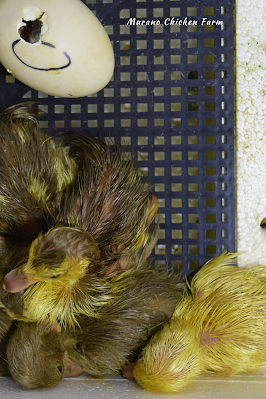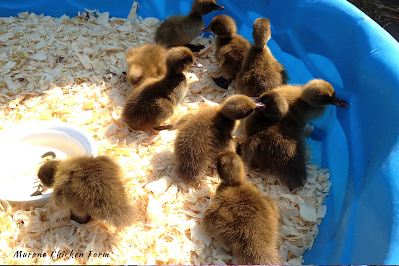The first time I incubated duck eggs I just popped the eggs in my incubator along with the chicken eggs and used all the same settings as I do for chicks. It worked and he hatched, but I would quickly find out that I needed to change a few things to have every hatch go perfectly.
Other than the longer incubation period, duck eggs and chicken eggs are quite similar in incubation procedure. With a few tweaks though, I started to get a better hatch rate and I was hooked on hatching my own ducklings.
Of course the easiest method is always to have a hen hatch the eggs if you have a broody hen. Either a chicken hen or duck hen will work, they both can hatch duck eggs just fine. It gets a little funny when the baby ducks try to swim in the water container though as chickens don't understand that behavior!
If you don't have a broody hen though, you'll have to chose and use an incubator.
Before we get started...if you're not real familiar with hatching chicks, keets or ducklings some of the terms I use can be confusing. Here is a list of Egg incubation terminology and their definitions to help you out.
How to incubate duck eggs
Chose clean, fertilized eggs that are less than 10 days old to incubate. Do not wash the eggs. Washing eggs removes the 'bloom' which is a natural, protective coating. Ducks have a more waxy coating than chicken eggs but that's because ducks are often wet, so this helps protect the eggs better.
Do not incubate cracked, damaged or misshapen eggs. Here's more information on how to handle hatching eggs before incubation.
Ducks are a ground nesting bird and many times the eggs seem particularly dirty (compared to chicken eggs) Select the cleanest eggs you can, or lightly buff off dirt with a dry cloth. Do not use soap or water as the less bloom you remove, the better!
Place your incubator in a draft free room out of direct sunlight. Turn your incubator on (and the egg turner if it has separate controls) 24-48 hours before setting eggs. Check the temperature several times and make sure it stays steady for at least 12 hours before setting eggs. The incubator should be kept at 99-99.5°F for forced air and 101-102°F for a still air incubator.
The temperature inside your incubator will drop when you first put the new eggs in it. This is normal. Don't touch the controls, it will come back to the correct temperature as soon as the eggs warm up.
Keep the humidity in the incubator between 55-65% for the first 25 days. If your incubator does not have an egg turner, turn the eggs 3-5 times a day.
I like to candle duck eggs after 10 days of incubation, though you can often see development after just 5 days. Using a strong flashlight or a candling light, look inside the egg. It helps if you're in a dark room. You should see a darkened blob with what looks like a red spider inside. It might also have a black spot in it.
Dispose of any eggs that are not developing. Return the developing eggs to the incubator. You don't have to move as quickly as when checking other poultry eggs, as it's not as big a problem if the eggs get a tiny bit cooler. I like to mist them with a water bottle after candling to add extra moisture into the incubator. I only do this with duck eggs!
Removing eggs that have stopped developing is important during incubation and right before lockdown. When an egg stops developing it starts to decompose. This can cause pressure to build up and the eggshell can pop open. If an egg breaks open inside your incubator it might ruin the rest of the hatch.
You want to remove these before they have a chance to pop as they smell really bad and are hard to clean up.
How to hatch ducklings
On day 25 stop turning the eggs. If you have a removable turner, take it out. Once you remove the turner make sure the temperature in the incubator doesn't drop, since egg turners sometimes have a motor that creates heat and adds to the incubators temperature.
Make sure you do this by day 25 in case your ducklings decide to hatch early! You don't want to have problems with a baby duck getting stuck in the turner or falling out of the egg trays! You will have to carefully adjust the incubator temperature if it gets too low. If your eggs are in suspended turning trays (like in a cabinet incubator) move them to the hatching area. Candle the eggs one last time and remove any that have quit developing.
It's especially crucial at the end stage of incubation to remove bad eggs since the ducklings will be hatching soon and the will start stumbling around inside the incubator. This movement can trigger a bad egg to pop.
Raise the humidity in the incubator to 65% by adding water to the water reservoir. If you can’t get the humidity high enough with the water reservoir alone, you can also add a piece of wet sponge. You'll probably have to add water during the days of lock down so try to position the sponge to make it easy.
I like to put a piece of non-slip material in the bottom of the hatcher (under the eggs) so the ducks can get a good grip with their little feet. It helps to prevent spraddle leg. Rubber shelf liner works great for this, or a thick washcloth.
From day 25 till about day 31 is considered "lock down". This is the crucial time while the ducklings are hatching. If you open the incubator during this time it can let the humidity out causing the membrane of the hatching ducks to dry out. Once the membrane dries, the ducklings are unable to move and can get stuck in their shells. This is called shrink wrapped.
The duck egg hatching process starts around day 25 as the duckling gets ready to hatch. Somewhere around day 28, the duckling will peck a hole in the egg with the little egg tooth on his bill. This is called pipping. Sometimes you will hear little ducky peeping even before they pip through the shell!
After they pip through the shell, they will slowly peck their way around the shell breaking through it all the way around. This is called zipping. They will then push the top off the egg and pop out.
There really is no 'typical' hatch. Sometimes a duckling will pip and zip in an hour. Others will pip then rest a few hours before they start zipping. Others will partially zip then rest. A baby duck can take up to 24 hours to hatch.
Leave newly hatched ducklings in the incubator until they're completely dry and fluffy. They can be moved to the brooder after 24 hours.
Related reading: How to raise ducklings!
You'll need to clean your incubator after each hatch. I have instructions for cleaning Styrofoam and plastic incubators. An incubator free of bacteria and debris gets a much better hatch rate and they're much easier to clean right after the hatch is complete.
Want to know more about ducks? Check out my collection of guinea articles: Keeping ducks 101.
~L
Want to know more about raising chickens? Click here for my top posts on chicken keeping!
Want information on raising chickens sent right to your email weekly? Click right here to join my list and get new posts sent directly to you the day they're published ... plus, you'll also get 4 free downloads including '25 Ways to save money raising chickens'.





No comments:
Post a Comment